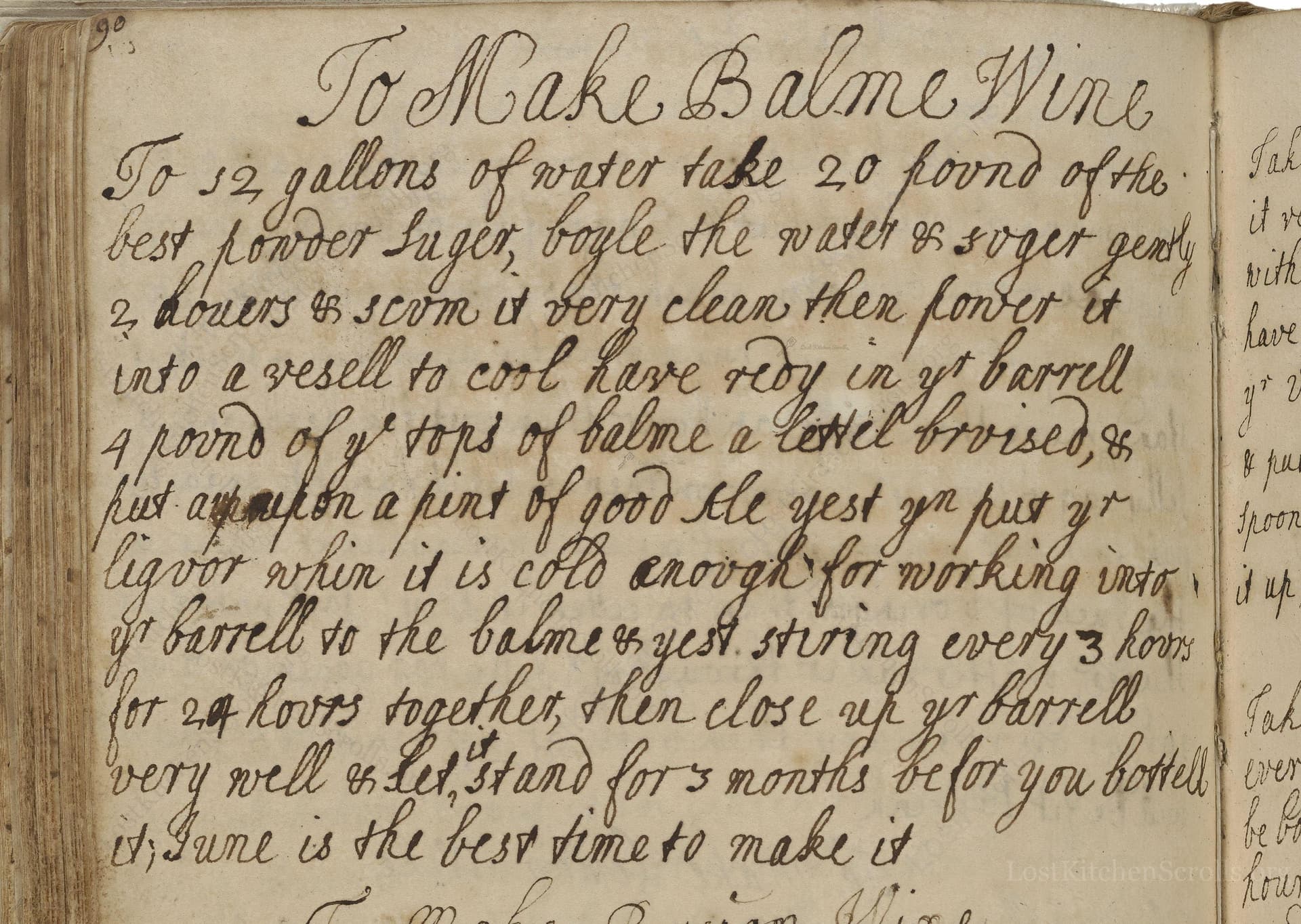To Make Balme Wine
From the treasured pages of Cook-book of Margaret Turner
Written by Margaret Eyre

To Make Balme Wine
"To 12 gallons of water take 20 pound of the best Powder Suger, boyle the water & suger gently 2 houers & scum it very clean then pouer it into a vesell to cool have redy in yr barrell 4 pound of ye tops of balme a lettel bruised, & put upon a pint of good ale yest yn put yr liquor when it is cold enough for working into yr barrell to the balme & yest. stiring every 3 hours for 24 hours together then close up yr barrell very well & let it stand for 3 months befor you bottell it; June is the best time to make it"
Note on the Original Text
The recipe is written in the vernacular of the early 18th century, using phonetically spelled words and abbreviated ‘yr’ (your), ‘yt’ (that) conventions. Measurement units and instructions are imprecise by today’s standards, with a reliance on judgment and seasonal cues. 'Powder Suger' refers to white sugar, while 'balme' is lemon balm. 'Ale yest' simply means ale yeast, and 'boyle' is to boil. Directions are sequential but assume familiarity with household brewing, expecting the reader to supply missing detail from experience. This charming informality offers a glimpse into domestic expertise and confidence of the era.

Title
Cook-book of Margaret Turner (1709)
You can also click the book image above to peruse the original tome
Writer
Margaret Eyre
Era
1709
Publisher
Unknown
Background
Step into the refined world of early 18th-century cookery with Margaret Eyre, where recipes are whispered secrets and culinary wonders await. From hearty roasts to delicate sweets, this charming tome serves up inspiration fit for the tables of historic England.
Kindly made available by
Folger Shakespeare Library
This recipe comes from a manuscript authored by Margaret Eyre, dating to around 1709. At the time, household wine- and beer-making were both practical and recreational pursuits among the English gentry. Lemon balm, known as 'balme,' was revered for its uplifting qualities and its reputed ability to 'comfort the heart.' Such herb wines were homemade alternatives to imported wines and reflected a vibrant tradition of using garden botanicals in fermentation. The recipe’s timing in June nods to the seasonal rhythms of early modern households, making use of herbs at their aromatic peak.

The original recipe would have employed a large copper or iron cauldron for boiling the sugar and water, wooden paddles for stirring, and simple skimmers for removing scum. Once cooled, the mixture would have been transferred to large wooden barrels or earthenware fermenting vessels. Yeast was often home-cultured from previous ale batches. The fermentation would take place in these barrels, sealed with wooden bungs or ‘close up’ tightly to allow for slow, gentle transformation. Today, we substitute with food-grade stainless steel or plastic fermenters, reliable modern yeast, and sterilized glass bottles for storage.
Prep Time
40 mins
Cook Time
2 hrs
Servings
60
We've done our best to adapt this historical recipe for modern kitchens, but some details may still need refinement. We warmly welcome feedback from fellow cooks and culinary historians — your insights support the entire community!
Ingredients
- 12 gallons water
- 20 lb powdered (caster) sugar
- 4 lb fresh lemon balm tops (Melissa officinalis), bruised
- 1 pint fresh ale yeast (or substitute: 1/3 oz active dry wine yeast, rehydrated)
- Optional: 1 pint fresh pale ale (as starter for yeast, optional)
Instructions
- To recreate this balme wine (or, as we might call it now, lemon balm herb wine), start by boiling 12 gallons of water with 20 pounds of fine white sugar in a large pot.
- Simmer gently for 2 hours, and skim off any foam that rises to the top to clarify the liquid.
- Allow this sweet syrup to cool.
- In a sanitized food-grade fermenter or barrel, place 4 pounds of fresh lemon balm tops (Melissa officinalis), slightly bruised to release their fragrance and flavor.
- Add about 1 pint of fresh ale yeast (or substitute: neutral white wine yeast), mixed with a small amount of ale (if desired).
- When the syrup has cooled to about 80–86°F (just warm to the touch), pour it over the balm and yeast in the fermenter.
- Stir well.
- For the next 24 hours, stir the mixture every three hours to help the yeast start working.
- Then, seal the fermenter with an airlock and let it ferment in a cool place for about 3 months.
- Once the fermentation is complete, carefully bottle the wine.
- Traditionally, June was the best time to make this, when lemon balm is at its freshest.
Estimated Calories
180 per serving
Cooking Estimates
It takes about 2 hours to cook the syrup and about 40 minutes to prepare the lemon balm and yeast. Each serving contains around 180 calories, and this recipe makes about 60 servings of herb wine.
As noted above, we have made our best effort to translate and adapt this historical recipe for modern kitchens, taking into account ingredients nowadays, cooking techniques, measurements, and so on. However, historical recipes often contain assumptions that require interpretation.
We'd love for anyone to help improve these adaptations. Community contributions are highly welcome. If you have suggestions, corrections, or cooking tips based on your experience with this recipe, please share them below.
Join the Discussion
Rate This Recipe
Dietary Preference
Main Ingredients
Culinary Technique
Occasions

Den Bockfisch In Einer Fleisch Suppen Zu Kochen
This recipe hails from a German manuscript cookbook compiled in 1696, a time whe...

Die Grieß Nudlen Zumachen
This recipe comes from a rather mysterious manuscript cookbook, penned anonymous...

Ein Boudain
This recipe comes from an anonymous German-language manuscript cookbook from 169...

Ein Gesaltzen Citroni
This recipe, dating from 1696, comes from an extensive anonymous German cookbook...
Browse our complete collection of time-honored recipes



